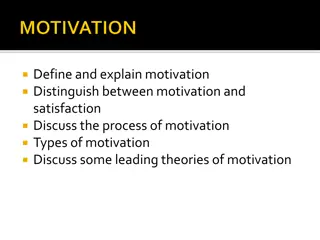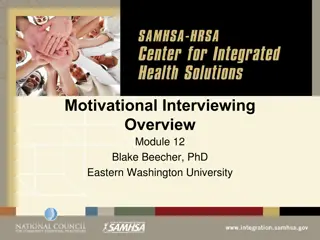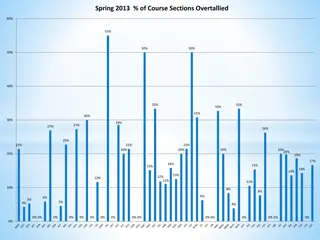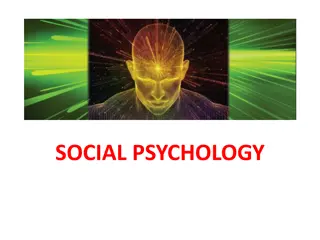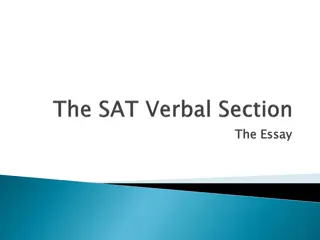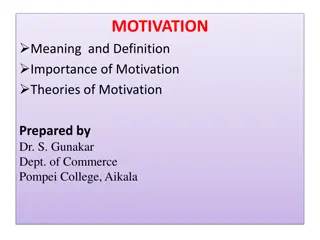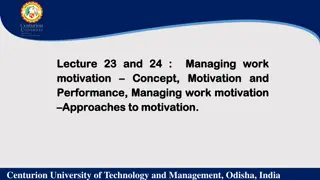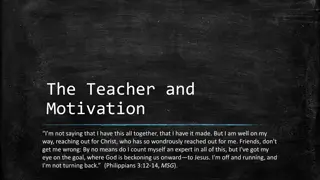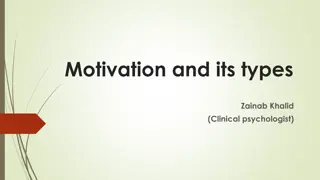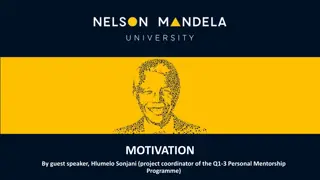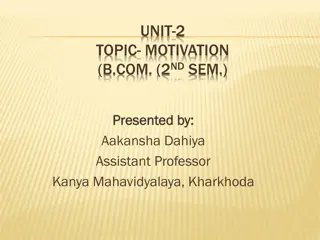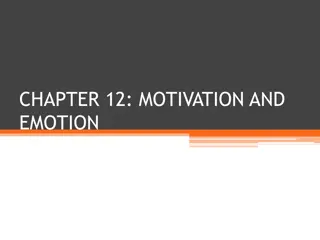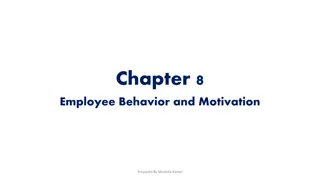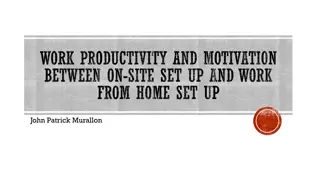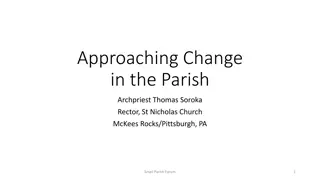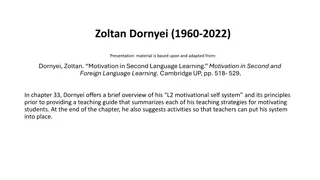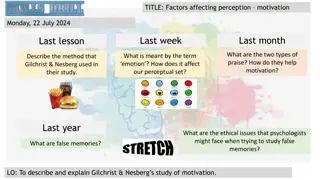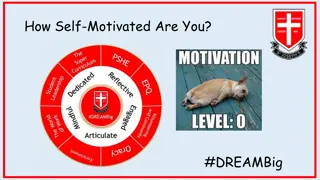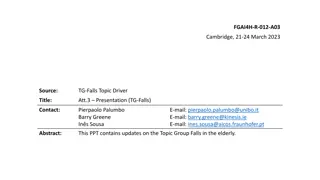Understanding Motivation and Change in Fall 2013
Delve into the various aspects of motivation and change in Fall 2013, exploring theories like Achievement Motivation Theory, Self-Determination Theory, Operant Conditioning, and Motivational Interviewing. Discover the complexities of motivating individuals and draw inspiration from historical events like the Roman Legion and the French Revolution. Unravel the definition of motivation, differentiate between external and internal motivation, and explore the reasons why we work. Learn that motivation is not directly observable, synonymous with satisfaction, always conscious, or directly controllable. Explore the Stages of Change Model in addiction treatment for a comprehensive understanding of motivating for change.
Download Presentation

Please find below an Image/Link to download the presentation.
The content on the website is provided AS IS for your information and personal use only. It may not be sold, licensed, or shared on other websites without obtaining consent from the author. Download presentation by click this link. If you encounter any issues during the download, it is possible that the publisher has removed the file from their server.
E N D
Presentation Transcript
MOTIVATING FOR CHANGE FALL 2013
MOTIVATING FOR CHANGE Ray Caesar LPC, LADC-MH Director of Addiction Specialty Programs Oklahoma Department of Mental Health & Substance Abuse Services (405)522-3870 rcaesar@odmhsas.org
OUTLINE Achievement Motivation Theory Self-Determination Theory Operant Conditioning Motivational Interviewing
MOTIVATING INDIVIDUALS
BREAD AND WATER http://ts3.mm.bing.net/th?id=H.4531664097184430w=255h=188c=7rs=1pid=1.7
MOTIVATION DEFINITION Motivation The process of arousing and sustaining goal-directed behaviors. NEEDS DRIVES DRIVES INCENTIVES
MOTIVATION WHAT IS MOTIVATION? http://ts1.mm.bing.net/th?id=H.4791793099474320w=226h=188c=7rs=1pid=1.7 External motivation http://ts3.mm.bing.net/th?id=H.4875175561333578w=172h=172c=7rs=1pid=1.7 Internal motivation
WHY WE WORK Support ourselves and our families. Pay bills. Most people enjoy work. Sense of purpose. Social aspect of being with other people.
MOTIVATION MOTIVATION IS NOT Directly observable Synonymous with satisfaction Always conscious Directly controllable
STAGES OF CHANGE The Stages of Change Model in Addiction Treatment
ACHIEVMENT MOTIVATION THEORY
ACHIEVEMENT MOTIVATION THEORY LOW ACHIEVEMENT MOTIVATION HIGH ACHIEVEMENT MOTIVATION
ACHIEVEMENT MOTIVATION THEORY LOW ACHIEVEMENT MOTIVATION Prefer very easy tasks Failure is unlikely or very difficult tasks Failure not embarrassing
ACHIEVEMENT MOTIVATION THEORY HIGH ACHIEVEMENT MOTIVATION Prefer moderately difficult tasks Success is attainable Success is attributable to skill and effort
EXTRINSIC AND INTRINSIC MOTIVATION
MOTIVATION EXTRENSIC AND INTRINIC MOVIVATION Extrinsic motivation A desire to perform based on external reward or threat of punishment Intrinsic motivation A desire to perform a behavior based on internal (personal) reward or punishment
EXTERNAL VERSUS INTERNAL Better to have intrinsic motivation. Behave not because you fear punishment or expect reward (external), but because you want to behave in a certain way (intrinsic). Motivation from Motivation from within within
COMPONENTS OF INTRINSIC MOTIVATION Autonomy: self-governing Competence: self-efficacy Relatedness: support and affirmation from peers.
EXTRINSIC MOTIVATION ~ Needed when there are no intrinsic motivators. An example is paying taxes ~ Hopefully the behavior will alter to intrinsic motivation over time. An example is seat belt use. At first extrinsic: avoid tickets, alarms, nagging children Over time this behavior becomes internalized
EXTRINSIC MOTIVATION Environment controls behavior External rewards and punishments Praise increases the likelihood of participation Criticism decreases the likelihood of participation Principles of operant conditioning are at work*
MOTIVATION Exposure to commercial media prompt a focus on materialism which provides fleeting satisfactions. Individuals may seek extrinsic rewards in order to compensate for deficits in fulfilling basic psychological needs. Extrinsic rewards are insufficient and poor compensation. Ryan & Deci
MOVING FROM EXTERNAL TO INTERNAL MOTIVATION
WHY WE WORK Support ourselves and our families. Pay bills. Most people enjoy work. Sense of purpose. Social aspect of being with other people.
SAFER TO WEAR SEATBELTS. It is well-known that seatbelts save lives. Compliance varies greatly. 91% in California 78% in Connecticut 51% in Mass before law, now 76%. Requirement and enforcement make a difference
PUNISHMENT AND REINFORCEMENT. Click it or ticket Threat of punishment. Random checks. Cars come with warning buzzers that stop if you buckle up. Reinforces compliance
EVENTUALLY INTERNALIZED Starts extrinsic. Not wearing seatbelt might lead to punishment. Wearing reinforced by others and by vehicle. Seat belt usage becomes a matter of habit. Becomes intrinsic.
SELF DETERMINATION THEORY Ryan and Deci
SELF-DETERMINATION THEORY A meta-theory of motivation incorporating multiple mini-theories into a unified whole. Self-Determination Theory addresses both intrinsic and extrinsic sources of motivation. Self-Determination Theory focuses on Autonomy Competence Relatedness
COMPONENTS OF INTRINSIC MOTIVATION Autonomy: self-governing Competence: self-efficacy Relatedness: support and affirmation from peers.
SELF-DETERMINATION THEORY Self-Determination Theory proposes that the degree to which autonomy, competence or relatedness are supported and enhanced will have a significant positive effect on the individual within the specific context.
SELF-DETERMINATION THEORY Self-Determination Theory proposes that the degree to which autonomy, competence or relatedness are unsupported or hindered will have a significant negative effect on the individual within the specific context.
SELF-DETERMINATION THEORY Autonomy, competence and relatedness are recognized as basic psychological needs.
PSYCHOLOGICAL NEEDS Not necessary for survival like biological needs. People engage in all kinds of activities unrelated to basic needs. Make life worth living.
SELF-DETERMINATION THEORY THE FIVE MINI-THEORIES OF SELF-DETERMINIATION THEORY
SELF-DETERMINATION THEORY COGNITIVE EVALUATION THEORY ORGANISMIC INTEGRATION THEORY CAUSALITY ORIENTATIONS THEORY BASIC PSYCHOLOGICAL NEEDS THEORY GOAL CONTENTS THEORY
SELF-DETERMINATION THEORY Cognitive Evaluation Theory
SELF-DETERMINATION THEORY Cognitive Evaluation Theory Intrinsic motivation What are the effects of social contexts on intrinsic motivation? Highlights competence and autonomy. Explores reward, ego-involvement, controls
SELF-DETERMINATION THEORY Organismic Integration Theory
SELF-DETERMINATION THEORY Organismic Integration Theory Extrinsic motivation Explores the determinants, properties and consequences of extrinsic motivation Identifies a continuum from external to internal Degree hindered autonomy will be enhanced or
SELF-DETERMINATION THEORY Causality Orientations Theory
SELF-DETERMINATION THEORY Causality Orientations Theory Intrinsic/extrinsic motivation Identifies how individual differences alter how the environment is perceived. Identifies three orientations autonomy, control (rewards) and impersonal (amotivational).
SELF-DETERMINATION THEORY Basic Psychological Needs Theory


